The world is becoming more and more interesting even as it is becoming more and more dangerous, whether you are in the metropolis or in the hamlet. Just as in an earlier story in Intervention this morning where President Tinubu of Nigeria was challenging blanket labelling of the country as a hub of cybercrime, Alex Leo South China Morning Post is, in the article below, on a war of metaphors (notwithstanding his disclaimer) in which China is building the world which the United States is bombing into ruins.
His column has the capstone: On Washington’s telling, Beijing is spreading authoritarianism through producing goods and building infrastructure around the world while the US is promoting freedom and democracy by bombing and selling weapons
The media theatre of the US-China peer competition can be very interesting, even more than the trade war theatre, for example. Hoping it doesn’t get to actual shooting stage! —Intervention
By Alex Leo
People nowadays say literally when they really mean metaphorically. I don’t know why; maybe a linguist can explain. But when I wrote literally in the headline, I meant literally.
Below is the first paragraph summing up a new study from the Centre for Economic Policy Research (CEPR), a pan-European independent research group.
“The US is the world’s sole military superpower. It spends more on its military than the ten next highest spending countries combined,” wrote Richard Baldwin, the study’s main author and a professor of international economics at IMD Business School in Lausanne, Switzerland.
“China is now the world’s sole manufacturing superpower. Its production exceeds that of the nine next largest manufacturers combined.”
His first factual statement about the United States is probably quite well-known. But he thinks the second one is not. “During ongoing work on global supply chain disruptions with my co-authors … I’ve noticed a stark fact that I don’t think is as widely known as it should be. China is now the world’s sole manufacturing superpower.”
Actually I did read something like that from a review by Paul Krugman, the Nobel Prize-winning economist, in Foreign Affairs magazine about a new book on how the US has weaponised the global economic and financial systems for its own foreign policy.
“China’s role as the workshop of the world … might be as hard to replace as the global role of the US dollar,” Krugman wrote.
So I gather China’s manufacturing prowess is starting to get noticed. Why? It’s most likely because as the US tries to isolate China economically and disrupt its worldwide supply chains, especially in hi-tech fields, it is causing enormous grief to suppliers, manufacturers and middlemen everywhere, not least in the US, as they find their Chinese partners are really tough to replace.
How much of a manufacturing superpower? Well, China produces more than the US, Japan, Germany, India, South Korea, Italy, France and the island of Taiwan combined.
Its share as a percentage of global gross production already equalled that of the next top 10 producers by 2020.
US production is three times more reliant on Chinese inputs than vice versa while Chinese manufacturers rely less and less on US supply.
Anyway, I can go on and on with the stats but you get the idea. Baldwin’s article provides several nifty, easy-to-understand graphics so you can check them out for yourself.
However, there is a single manufacturing sector over which the US exercises complete global dominance; you guessed it, weapons.
Worldwide military spending in 2022 hit US$2.2 trillion, the highest since the end of the Cold War, according to the Stockholm International Peace Research Institute. And the US defence industry accounts for a staggering 45 per cent of all such sales around the world.
With two hot wars in Ukraine and Palestine, and US spending on the military approaching US$1 trillion per year, the Big Five – Lockheed Martin, RTX Corporation, Boeing, Northrop Grumman and General Dynamics – are salivating over the profit prospects of the coming years.
If you really want to understand how the arms industry works, listen to their conference calls with financial analysts. It’s cold-blooded capitalism at its purest.
Consider this earnings call in October. An analyst from TD Cowen, part of TD Asset Management, which held about US$16 million in General Dynamics stocks, asked: “Hamas has created additional demand, we have this US$106 billion request from the (US) president. Can you give us some general colour in terms of areas where you think you could see incremental acceleration in demand?”
Jason Aiken, General Dynamics’ chief financial officer, replied: “I think if you look at the incremental demand potential coming out of that, the biggest one to highlight and that really sticks out is probably on the artillery side.”
At a similar earnings call with RTX in the same month, there was a question from a top analyst at Morgan Stanley, which owned a whopping US$3 billion worth of RTX, formerly Raytheon, stocks: “Looking at (the White House’s US$106 billion funding request), you’ve got equipment for Ukraine, air and missile defence for Israel, and replenishment of stockpiles for both. And this seems to fit quite nicely with the Raytheon defence portfolio.
“So how much of this opportunity is addressable to the company and if the dollars are appropriated, when would be the earliest you could see this convert to revenue?”
Greg Hayes, RTX’s chairman and executive director, replied: “I think across the entire Raytheon portfolio you’re going to see a benefit of this restocking on top of what we think will be an increase in the DoD (Department of Defence) top-line as we continue to replenish these stocks.” He estimated that supplying Ukraine alone would be worth billions in revenues over the coming few years with profit margins of up to 12 per cent.
A late November headline from The Washington Post said it all: “Ukraine aid’s best-kept secret: Most of the money stays in the U.S.A.” You don’t say!
According to a report by the Washington-headquartered Quincy Institute for Responsible Statecraft, of the 46 active conflicts around the world, the US provided arms to one or more parties for 34 of them. That was almost three out of four conflicts!
Comedian Mel Brooks had this classic number called Springtime for Hitler. Well, it’s springtime for America’s merchants of death; except they are not called that any more, but rather patriots doing their duty.
More wars and armed conflicts also mean looser regulations, less restrictive but longer contracts, price gouging, faster approval of foreign sales and the construction of new weapons plants – all for doing business with the US government.
Of course, we are not saying that the US doesn’t build and provide aid in countries around the world, or that China isn’t a significant player in the global arms market. But that picture is a lot less significant to both countries and their political economy, as well as to wars and conflicts around the world, than the profiles we have been addressing here.
Now, if we pair all that with the anti-China narrative from Washington, you would have to conclude that Beijing is spreading authoritarianism through producing goods and building infrastructure while America is promoting freedom and democracy by bombing and selling weapons around the world.
Remember what George Orwell wrote? “War is peace. Ignorance is strength.” Reality is easily turned upside down.




























